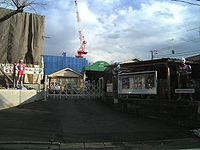
Tsuburaya Productions
Encyclopedia
is a Japan
ese special effects studio founded in 1963 by special effects wizard Eiji Tsuburaya
and was run by his family, until October 2007, when the family sold the company to advertising agency TYO Inc. The studio is best known for producing the original Ultraman
TV series, as well as the Ultra Series
. Since 2007, the Head Office has been located in Hachimanyama, Setagaya, Tokyo
.
 First established in 1963, it was responsible for the creation of such classic shows as Ultraman
First established in 1963, it was responsible for the creation of such classic shows as Ultraman
(and its many sequels
), Kaiju Booska
and many other spectacular tokusatsu
family/children's shows.
The company's current logo was originally the arrow-like logo from their 1968 TV series, Mighty Jack
, designed by that show's art director, Tohru "Tohl" Narita.
The company, when first formed in 1963, was called . In 1968, Toho Company Ltd.
forced the company to change the name to just "Tsuburaya Productions," not only because they thought Eiji acted as though only he can do special effects, but they also felt that his own TV shows were becoming a strong competition to the movies he was doing for them. Although Eiji had strong political power at Toho, he and the company were at odds with each other until his death in 1970.
Their more recent work includes the "Ultra N-Project" (Ultraman the Next
and Ultraman Nexus
) and Bio Planet WoO
, based loosely on an unused concept which was planned before the production of Ultra Q
, but never filmed.
, the main licensor of merchandise for the Ultra Series, acquired a 33% stake. As a result, the old Kinuta Office used by Tsuburaya as its Head Office has been razed, and the company has moved to newer facilities. Many fans felt this to be the end of an era.
Kazuo Tsuburaya, Eiji's grandson, is staying with the company on its board of directors.
Japan
Japan is an island nation in East Asia. Located in the Pacific Ocean, it lies to the east of the Sea of Japan, China, North Korea, South Korea and Russia, stretching from the Sea of Okhotsk in the north to the East China Sea and Taiwan in the south...
ese special effects studio founded in 1963 by special effects wizard Eiji Tsuburaya
Eiji Tsuburaya
was the Japanese special effects director responsible for many Japanese science-fiction movies, including the Godzilla series...
and was run by his family, until October 2007, when the family sold the company to advertising agency TYO Inc. The studio is best known for producing the original Ultraman
Ultraman
is Japanese television series that first aired in 1966. Ultraman, the first and best-known of the "Ultra-Crusaders," made his debut in the tokusatsu SF/kaiju/superhero TV series, , a follow-up to the television series Ultra Q...
TV series, as well as the Ultra Series
Ultra Series
The is the collective name for all the shows produced by Tsuburaya Productions featuring Ultraman, his many brethren, and the myriad Ultra Monsters. The Ultra Series is one of the prominent tokusatsu superhero genre productions from Japan, along with Toei produced series Kamen Rider, Super...
. Since 2007, the Head Office has been located in Hachimanyama, Setagaya, Tokyo
Tokyo
, ; officially , is one of the 47 prefectures of Japan. Tokyo is the capital of Japan, the center of the Greater Tokyo Area, and the largest metropolitan area of Japan. It is the seat of the Japanese government and the Imperial Palace, and the home of the Japanese Imperial Family...
.
History

Ultraman
is Japanese television series that first aired in 1966. Ultraman, the first and best-known of the "Ultra-Crusaders," made his debut in the tokusatsu SF/kaiju/superhero TV series, , a follow-up to the television series Ultra Q...
(and its many sequels
Ultra Series
The is the collective name for all the shows produced by Tsuburaya Productions featuring Ultraman, his many brethren, and the myriad Ultra Monsters. The Ultra Series is one of the prominent tokusatsu superhero genre productions from Japan, along with Toei produced series Kamen Rider, Super...
), Kaiju Booska
Kaiju Booska
is a famous children's tokusatsu sitcom, and the first to feature the friendly monster Booska. Produced by Tsuburaya Productions, the show aired on Nippon TV from November 9, 1966 to September 27, 1967, with a total of 47 episodes....
and many other spectacular tokusatsu
Tokusatsu
is a Japanese term that applies to any live-action film or television drama that usually features superheroes and makes considerable use of special effects ....
family/children's shows.
The company's current logo was originally the arrow-like logo from their 1968 TV series, Mighty Jack
Mighty Jack
was a tokusatsu SF/espionage/action TV series. Created by Japanese effects wizard Eiji Tsuburaya, the show was produced by Tsuburaya Productions and was broadcast on Fuji TV from April 6, 1968 to June 29, 1968, with a total of 13 one-hour episodes...
, designed by that show's art director, Tohru "Tohl" Narita.
The company, when first formed in 1963, was called . In 1968, Toho Company Ltd.
Toho
is a Japanese film, theater production, and distribution company. It is headquartered in Yūrakuchō, Chiyoda, Tokyo, and is one of the core companies of the Hankyu Hanshin Toho Group...
forced the company to change the name to just "Tsuburaya Productions," not only because they thought Eiji acted as though only he can do special effects, but they also felt that his own TV shows were becoming a strong competition to the movies he was doing for them. Although Eiji had strong political power at Toho, he and the company were at odds with each other until his death in 1970.
Their more recent work includes the "Ultra N-Project" (Ultraman the Next
Ultraman (2004 film)
Ultraman: The Next, released in Japan simply titled , is a 2004 tokusatsu superhero film. It is part of the Ultra Series' experimental Ultra N Project, and features an Ultraman character codenamed "The Next"...
and Ultraman Nexus
Ultraman Nexus
was produced by Tsuburaya Productions and Chubu-Nippon Broadcasting. It was the 20th entry in the Ultra Series. The series aired on Tokyo Broadcasting System, including TBS, CBC, MBS, etc. The show ran from October 2, 2004 until June 25, 2005, with a total of 37 broadcast episodes...
) and Bio Planet WoO
Bio Planet Woo
is a "kyodai" themed tokusatsu that premiered April 9, 2006 and aired at 7:30pm on NHK and ran for 13 episodes. WoO was one of many unused ideas created by the late-Eiji Tsuburaya as story connecting to the show, Ultra Q...
, based loosely on an unused concept which was planned before the production of Ultra Q
Ultra Q
is a tokusatsu SF/kaiju series made in the tradition of Toho's many tokusatsu sci-fi/horror films.Produced in black and white by Tokyo Broadcasting System/Tsuburaya Productions, this is actually the first of the long-running Ultra Series, and was broadcast on Tokyo Broadcasting System from January...
, but never filmed.
Buyout from TYO
In October 2007, due to rising production costs, the Tsuburaya family sold the company to Japanese advertising agency TYO Inc., which now has an 80% stake in the company, with Tsuburaya itself owning 68%. BandaiBandai
is a Japanese toy making and video game company, as well as the producer of a large number of plastic model kits. It is the world's third-largest producer of toys . Some ex-Bandai group companies produce anime and tokusatsu programs...
, the main licensor of merchandise for the Ultra Series, acquired a 33% stake. As a result, the old Kinuta Office used by Tsuburaya as its Head Office has been razed, and the company has moved to newer facilities. Many fans felt this to be the end of an era.
Kazuo Tsuburaya, Eiji's grandson, is staying with the company on its board of directors.

